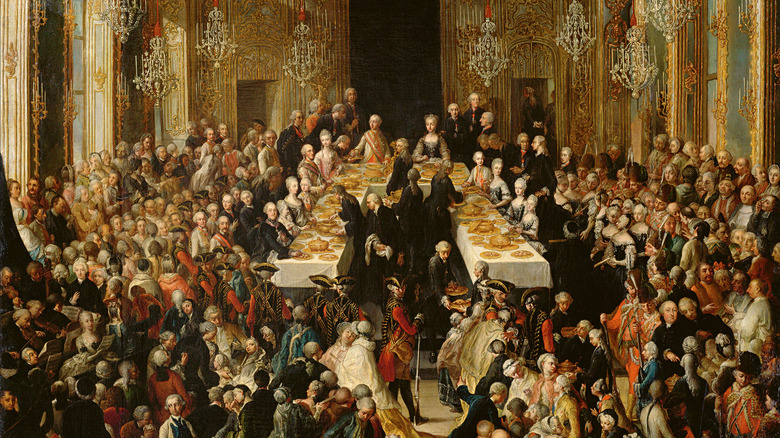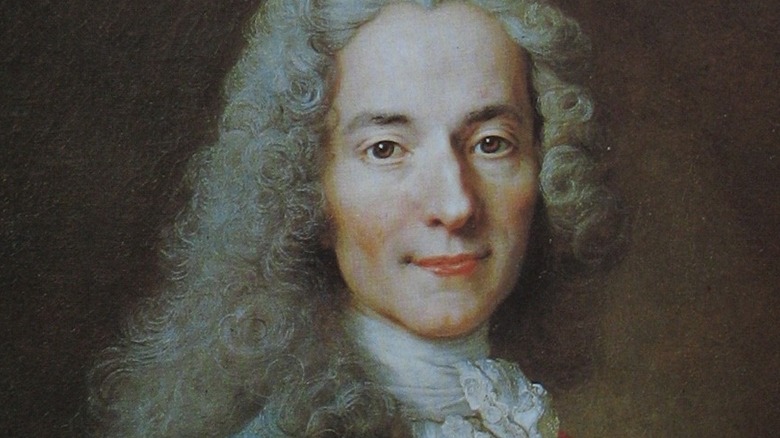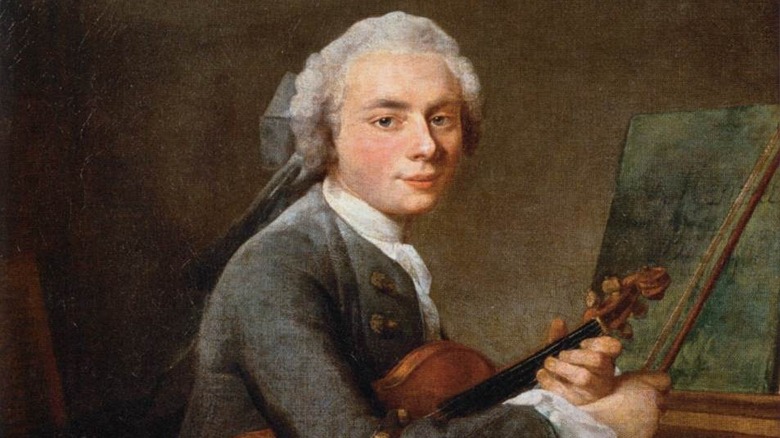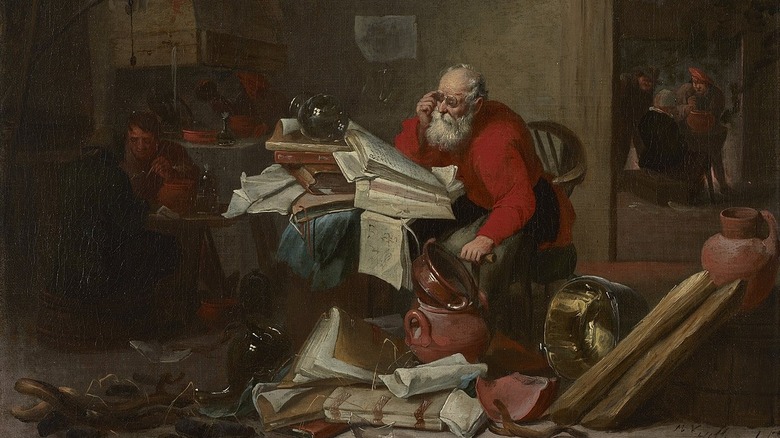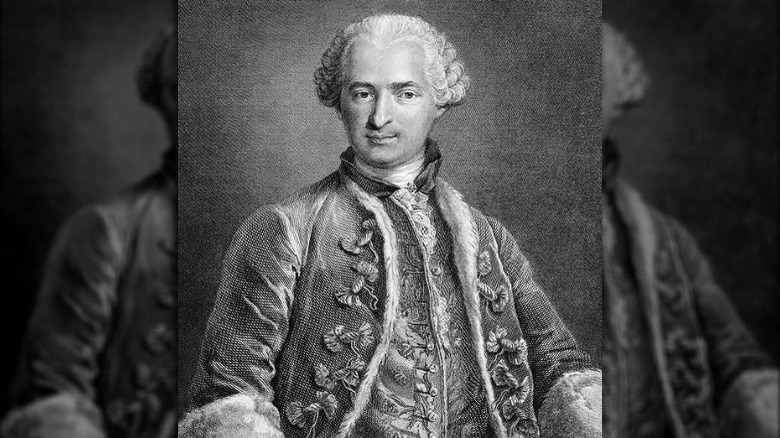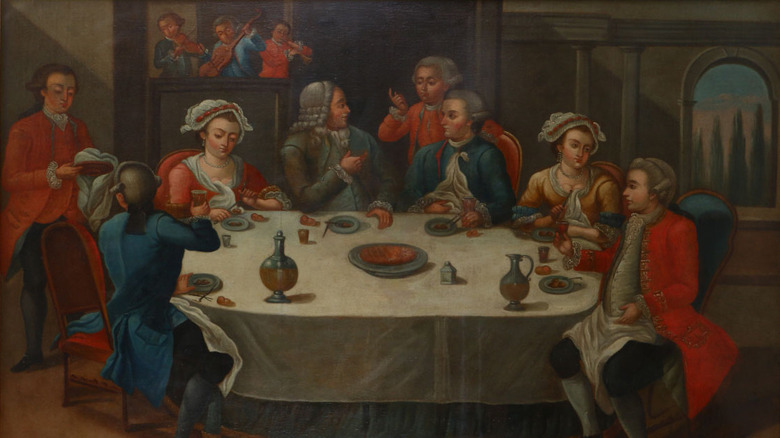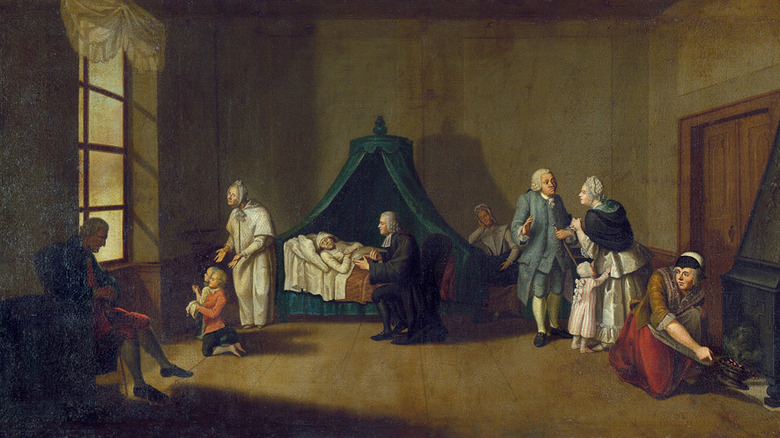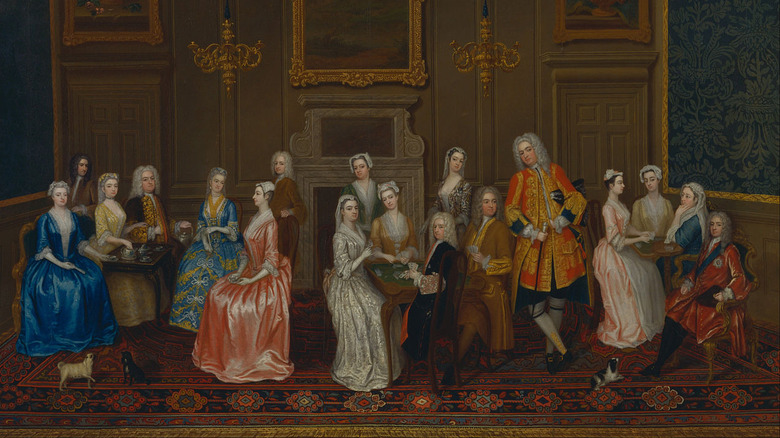The Bizarre True Story Of The Count Of Saint Germain
Who hasn't wanted to live forever at one point or another? It seems like a pretty alluring prospect, at least at first. Of course, as "Highlander," "The Vampire Chronicles," and just about any other fictional work dealing with immortality will let you know, living forever probably won't be as cracked up as many first think it is. If nothing else, you might have to deal with endless confusion and wild tales, as the Count of Saint Germain would surely tell you.
Well, that all depends on whether or not if the Count exists. By all of the more or less reliable accounts, he appears to have been an actual person who traveled about Europe in the 18th century, making appearances at various parties and royal courts. But some grew suspicious of this obscure man's many talents, good looks, and learning. They started to wonder just what, exactly, was this mysterious man's deal. Why did he never talk about where he came from? How did he gain so much knowledge? Why did he keep getting embroiled in different political circles?
Perhaps he was a lost prince, a spy, or even an audacious upstart who had conned his way into the upper echelon of society. But his story doesn't stop there. Some went so far as to allege that the Count was an occult mastermind who may have just uncovered the secret of eternal life. Could they possibly be right? This is the bizarre true story of the Count of Saint Germain.
The Count of Saint Germain was a real person with a mysterious past
Though there are plenty of rumors swirling about that complicate the story of the Count of Saint Germain, the truth is that he was, at one point in history, a very real person. Yet, that doesn't mean we can be sure that we fully understand him, as the Count seemed committed to muddying the waters of his own life story. It could well be that, given how much he circulated in some very upper-class realms, he was simply hiding humble origins. Or, as more fantastically-minded folks like to claim, he could have been hiding a more mystical secret.
According to Britannica, various notables of the 18th century confirmed his existence. Writer and politician Horace Walpole wrote that the Count of Saint Germain was in London in 1743, where he was arrested on espionage charges, but then quickly let go. According to "A Dark Muse," this is the first confirmed mention of Saint Germain, who was kicked out of England after his release.
Years later, he pops up in the court of French king Louis XV but, after a brief bout with serious political influence and infighting, he fled back to England. Seemingly never one to stay in a single place for very long, he then travels in Russia's political circles, then Germany, a few years back in France, and finally Germany for a last time before his death in what many sources say was the year 1784.
Voltaire and Casanova got snippy about him
The Count of Saint Germain was, per "A Dark Muse," a real charmer who impressed not only with good looks and class, but also skill and intelligence. His reportedly youthful appearance was the likely source of later rumors about his immortality and occult skill, but it's also just as likely that the real Count of Saint Germain knew how to take care of himself and didn't pig out at notoriously lavish 18th century dinner parties.
Still, as much as he seemed to gain some devoted admirers, there were just as many people who didn't like the Count's reputation at all. The French writer and philosopher Voltaire, already fairly notorious for his razor-sharp wit, turned his acid tongue on the Count of Saint Germain, too. In "The Comte de St. Germain," 20th century writer Isabel Cooper-Oakley claims that Voltaire was pretty skeptical of this guy making waves in Europe's social scene. In a letter addressed to King Frederick of Prussia, Voltaire wrote that a "M. de St. Germain" would surely meet the monarch eventually. "He is a man who never dies, and who knows everything," Voltaire sarcastically remarked.
Even the ultimate 18th century bad boy, Giacomo Casanova, turned up his nose at the Count. In Casanova's memoirs, he wrote that he would be interested in dining with Saint Germain, "whose wild talk amused me." Yet, Casanova also plainly stated that he thought the Count's claims were "bare-faced lies," which were nonetheless "astonishing."
He was known as an accomplished musician
It seems altogether safe to say that, whether or not the Count of Saint Germain was really an ageless alchemical genius, he was pretty good at playing the violin. Or, as The Musical Times reports, he became fairly well known as an all-around musician, playing not only the violin but a variety of other instruments, including the harpsichord. Saint Germain broke out his talents at various dinner parties and get-togethers over the years. Horace Walpole wrote that "his Play indeed is delightful! The violin in his Hands has all the Softness & Sweetness of a Flute, & yet all the Strength of the loudest Strings."
Saint Germain might not have had the complete virtuosity of some other famous instrumentalists of the day, at least in Walpole's opinion, but he was clearly a trained musician with a good understanding of the art. And, true to his reportedly lady-killer nature, some wrote that he appeared to be a truly passionate musician who fixed some audience members with an intense gaze. Lady Jemima, a London noble and socialist, wrote that "Woe! be to the Person within the reach of his Eye! for he makes Love so violently they must have a most Inflexible Countenance to stand it" (via The Musical Times).
He also composed some works, according to the Society for Eighteenth Century Music. These include some confirmed operatic arias, a spate of more folksy English songs, seven violin solos, and six sonatas.
The Count of Saint Germain garnered an occult reputation
While we can be pretty certain that the Count of Saint Germain was a good, perhaps even great, musician and someone who was interested in making powerful friends, that's not the real allure of his story for many people. Instead, things get more interesting when we discard all the documented facts about his many moves, likely political maneuverings, and musical stylings, and instead focus on the occult.
The Count was purportedly accomplished in an astonishing variety of things but may have garnered the most attention for his alchemical work and associations with forbidden knowledge. Of course, this necessarily involves quite a bit more speculation and less confirmed truth, so be sure to take any and all claims of Saint Germain's eerie doings with a substantial grain of salt.
According to liveabout, some of the rumors surrounding the Count of Saint Germain claimed that he was a quasi-chemist who could both grow diamonds and knew how to get rid of pesky wrinkles. Some even claimed that he had connections to secret brotherhoods, including the Illuminati, the Templars, and the Freemasons. He also claimed to be "very old" on occasion, though it's not clear whether he meant to be taken seriously or was just joking around with gullible rich folks. But many certainly wanted to believe that he was an alchemist who set up complex lab equipment and maybe, just maybe, knew the secret of creating gold and stealing eternal life.
Some people began to believe that he was very old
One of the key facets of the Count of Saint Germain's story is the claim that he was old. And, no, not just a man who looked pretty good for being 50 and living in the disease hotspot of 18th century Europe. To that end, some people went so far as to speculate that the Count was far, far older than all that, with a history that could well stretch back millennia.
Some of the rumors may have begun with the Count's own hints that he was far older than he looked, which could have been only some good-natured ribbing at one dinner party or another. Yet, according to liveabout, a Countess von Georgy claimed that she had known a Count of Saint Germaine once. Only, she had met the man in 1710 and, 50 years later, the Count looked hardly different at all. He admitted to having met with her decades ago and said only that "I am very old." Was that an admission of true age or only a self-effacing remark? Or could the countess have been indulging in fantastic gossip and nothing more?
Add to this a few other odd circumstances — like the Count being weirdly hush-hush about his background and clearly knowing quite a lot about many different subjects — and it's easy to see why some people grew very suspicious of this close-lipped man.
The Count of Saint Germain may have been a spy
Imagine, for a moment, that you're an 18th century partygoer. You've just met this fascinating man who's accomplished, urbane, and has just impressed everyone with his scientific knowledge and musical acumen. And he's clearly hobnobbing with important political people at the event. In fact, now that you think of it, you've heard that this mysterious, compelling man has appeared at quite a few courts over the years, always with a hand in the political realm, sometimes even acting as an advisor. You've just had a brilliant idea. Could this literal international man of mystery actually be a spy?
That's one interpretation of the Count of Saint Germain's activities throughout 18th century Europe. As Britannica reports, it's understood that he spent a few years at the court of Louis XV of France, who tasked him with carrying out clandestine jobs, which liveabout claims included espionage in England, where the Count would indeed travel after a purported dispute with French officials.
He may well have done similar work for Germany and, later, allegedly was embroiled with a Russian plot to overthrow Tsar Peter III and replace him with Catherine the Great. Some even go so far as to say that he popped up in France at least once more to warn Louis XVI and Marie Antoinette that the French Revolution was coming for their heads. It appears to be one of the few political occasions where people didn't listen to him.
The Count issued a surprising deathbed confession
If you tend towards the belief that the Count of Saint Germain was a regular human man (maybe with some really excellent skin and forward-thinking ideas about health and science), then it's surely no surprise to learn that he eventually died. According to liveabout, the Count of Saint Germain's end came in 1784, when he was living in the home of Prince Charles of Hesse-Cassel in Germany. The Prince was by the Count's side when he died and, according to Owlcation, heard an astonishing confession there.
Reportedly, Saint Germain admitted that he was actually a deposed Transylvanian prince named Francis Rakoczy II. "Francis" claimed to have earned a fantastic education at the University of Siena, explaining his good manners and serious learning. And, according to Britannica, there really was a Ferenc Rákóczi II who died in 1735. However, the timelines and calculated ages of the two men don't quite line up, leading many to believe that Saint Germain was still obscuring the truth for some unknown reason. Or, it could have been that he was a forgotten son of the departed prince.
It's possible that he came from far humbler origins and just didn't want to admit it and see all of his party invites and political connections dry up. Or, as many of us certainly like to do, the Count also enjoyed a great story and wasn't willing to break the spell even at the end of his life.
Death perhaps wasn't the end for the Count of Saint Germain
Even though death seems pretty darn final, in the case of the Count of Saint Germain, things don't end there. If you think that the man himself truly met his end in 1784, you can't deny that his story has developed a life of its own and has continued on for far longer.
And the stories that arose after Saint Germain's death can get pretty wild, though some may also be cases of mistaken identity or maybe even opportunistic charlatans capitalizing on the legend. According to liveabout, the first "sighting" of the Count of Saint Germain after his ostensible death took place in 1785, when he was supposedly spotted hanging out with hypnotist Anton Mesmer in Germany. That same year, the Count was reportedly chosen as a Freemason representative for a convention (though you could easily blame shoddy record-keeping in that instance, or maybe even a postmortem honor).
He also reportedly popped up in the aftermath of the fall of the Bastille, holding conversations with a French noble, the Comtesse d'Adhémar, where he claimed to predict France's future after the incredible upheaval of the French Revolution. The Comtesse claimed to see him on a few more occasions until 1820, writing that, each time she met with the man she believed to be Saint Germain, he never seemed to age a day.
Quite a few people have claimed to be the immortal Count of Saint Germain
By the 19th century, liveabout reports, some people had begun to suspect that the Count of Saint Germain maybe cheated death and had started a new life under a different name. It would be a pretty bog-standard tactic for an immortal, if you choose to believe that fictional works like "Highlander" might be real.
In the Count's case, he reportedly appeared as a "Major Fraser." Or, well, someone who others believed looked an awful lot like the Count came around under that name. Fraser was also highly accomplished and liked to hint that he had come about his knowledge through interactions with historical personages like ancient Roman emperor Nero or the medieval Italian poet Dante. Later, towards the end of the 19th century, mystic Helena Blavatsky assured people that Saint Germain was still kicking and pushing for better spiritual awareness. Eventually, as the Encyclopedia of Latin American Religions notes, he became a key figure in Blavatsky's Theosophy practice as well as other metaphysical disciplines.
The last person to gain some level of widespread attention for a supposed connection to the Count of Saint Germain was a 20th century French man known as Richard Chanfray (via liveabout). During the 1970s, Chanfray began appearing on television, claiming to be the count and supposedly demonstrating the ability to transmute boring old lead into gold in front of an audience. However, Chanfray later died by suicide in 1983.
He's linked to a New Orleans 'vampire'
In the midst of all the sensationalist tales of alchemy, spycraft, and immortality, it could well be that the wildest story linked to the Count of Saint Germain comes to us courtesy of New Orleans and a mysterious, bloody vampire. Well, maybe. Like so many legends associated with the Count, it's hard to tell the difference sometimes between the truth of the matter and mere gossip.
The legend, as related by WGNO New Orleans, holds that a man going by the name of Jacques St. Germain appeared in the city in 1904. He reportedly looked quite a lot like the original Count (though it's worth wondering how people could confirm such a thing) and set up home in a house that soon became known for its parties. Only, it's said that Jacques St. Germain was never seen eating or drinking.
Eventually, a sex worker jumped from a second-floor balcony and told police that St. Germain had attempted to drink her blood. The police were skeptical but, when they tried to track down St. Germain to get more information, they found that he had disappeared. Left behind in the mansion were blood stains and various vessels filled with blood. Pelican State of Mind also claims that they found clothes from a variety of eras, also apparently stained with blood, while there was an absolute and alarming lack of food anywhere in the home. Jacques himself was never seen again.

